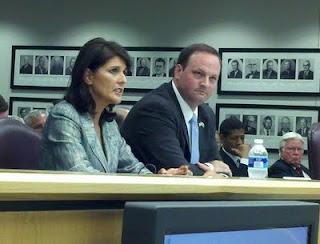Decline of labor unions a good thing, increasing competition
Ramesh Ponnuru:
The liberal writer John B. Judis, who means to offer a compliment, says it “may be the most radical thing the Obama administration has done.” He is referring to the National Labor Relations Board’s complaint against Boeing Co. (BA)Unions are so unproductive that they require a monopoly within an industry in order to survive. They cannot compete with non union companies. It is not just wages that are the problem. Stifling work rules create inefficiencies and lead to feather bedding which prevent the companies from reacting quickly to changing circumstances in the market.
The company wants to produce airliners in a nonunionized plant in South Carolina rather than a unionized one in Washington state, in part because of repeated strikes at its facilities in the Puget Sound area. The NLRB says the move is illegal union-busting.
Republicans and business groups are apoplectic. They call the complaint a payoff to the unions, question its legal basis and portray it as an assault on the country’s 22 right-to-work states, which prohibit making union membership a condition of employment. Sixteen Republican governors have asked that the complaint be dismissed. But rather than backing down, the NLRB has further angered its critics by proposing to speed up employee votes on whether to unionize. Employers say they need time to make the case against unions, but the board calls a longer voting process “an unnecessary barrier” to unionizing.
Underlying this dispute -- and an earlier one over Democratic proposals to let unionizing elections take place without a secret ballot -- is a fundamental difference in perspective about the decline of unions. Liberals fear it will lead to the immiseration of the middle class. Conservatives tend to see it as inevitable and beneficial, because unions undermine the competitiveness that modern economies require.
...
This storyline gets one thing right: Government policy did have a lot to do with the decline of unions. But it wasn’t labor law that mattered. In a study of the decline of unions between 1973 and 1988, economist Henry Farber and sociologist Bruce Western found that the chief reason was that nonunionized companies grew faster than unionized ones. Employment at unionized companies dropped by 2.9 percent per year while employment at nonunionized companies rose by 2.8 percent a year.
Another paper by the same authors confirms that the union elections overseen by the NLRB were a sideshow: If the NLRB had held no unionization elections since 1972, the percentage of Americans in unions would have dropped by only an additional 1.7 percent.
You might be thinking that unionized companies shrank mainly because they tended to be in declining industries. But you would be wrong. Economist Barry T. Hirsch has found that only 20 percent of the decline in unions between 1983 and 2002 resulted from shrinking unionized industries. Eighty percent of it resulted from a decline within industries. Take manufacturing: Between 1973 and 2006, the number of unionized workers in that sector dropped by 6 million, but the number of nonunion employees rose by 1.5 million. In short, unions declined because unionized companies couldn’t compete with nonunionized ones.
...

Comments
Post a Comment